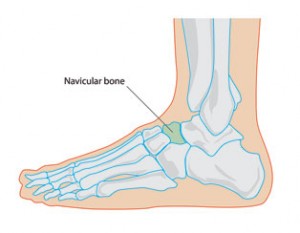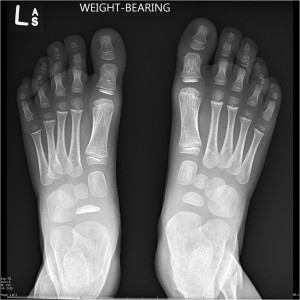Kohler’s disease is a rare bone disorder found in children. Children usually present with a painful mid-foot and find it difficult to apply pressure on the area. It is most commonly found in boys and can be found in children usually between the ages of 4-5, however may present as early as 2 years.
The bone that is commonly affected is known as the navicular. This is the bone that is said to be the last to develop at the feet, usually around the age of 5 and can be seen in the diagram below.
In Kohler’s disease, the abnormal development of the navicular is observed. An increase in density is generally noticed in an x-ray, as can be seen in the diagram below.
The cause for this increase in density or irregular development is not clearly understood, however a few hypothesis have been put forth. This includes the understanding that as the navicular is the last bone to develop in the foot, it may be suppressed between the talus bone and the cuneiform bones of the feet, as they are already developed at this stage. Therefore, this may cause compression of the blood vessels supplying the navicular bone, causing it to have irregular development, as there is reduced oxygen to the bone and therefore pain (Waugh, 1958).
Children that present with Kohler’s disease, generally have a limp as they walk and tend to walk on the outer edge of the foot, so as to reduce the pressure in the area.
Some other common signs or symptoms would include:
- Warmth
- Redness
- Pain
- Swelling
Further diagnostic imaging, such as an X-ray may be required to confirm the diagnosis.
The duration of the symptoms do vary from a few weeks, to a year. Most children do tend to grow out of the discomfort, as the bone regains its size and structure. Treatment plans vary between children as it would depend on the intensity and duration of the discomfort felt. The basic aim of the treatment plans would be to reduce the discomfort felt, therefore involving offloading methods, including rest, orthoses or casts.
If your child seems to be presenting with any midfoot pain, please do come in to visit your friendly podiatrist for further assessment! Always happy to help!
References
www.radiopaedia.org
http://www.ncbi.nlm.nih.gov/pmc/articles/PMC3298227/
http://www.orthopedicsforkids.com/PDFs/Feet/KOHLER%20DISEASE_2009.pdf


